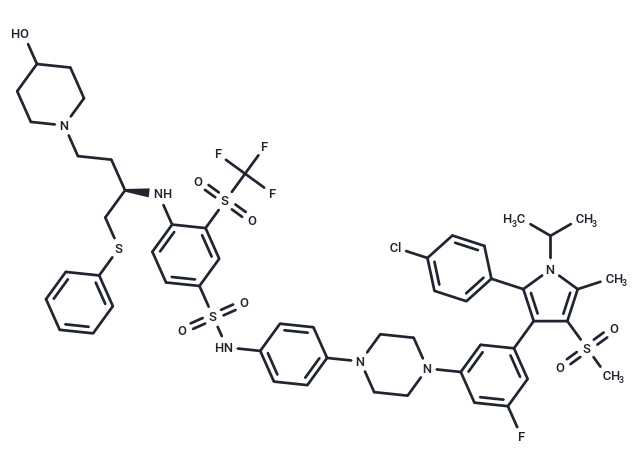Shopping Cart
- Remove All
 Your shopping cart is currently empty
Your shopping cart is currently empty

BM-1197, a highly potent and specific dual inhibitor of Bcl-2 and Bcl-xL, effectively targets these proteins with IC50 values of 3.5 nM and 5.2 nM for Bcl-2 and Bcl-xL, respectively. This compound demonstrates notable antitumor activity in both in vitro and in vivo settings.

| Pack Size | Price | Availability | Quantity |
|---|---|---|---|
| 5 mg | Inquiry | Backorder |
| Description | BM-1197, a highly potent and specific dual inhibitor of Bcl-2 and Bcl-xL, effectively targets these proteins with IC50 values of 3.5 nM and 5.2 nM for Bcl-2 and Bcl-xL, respectively. This compound demonstrates notable antitumor activity in both in vitro and in vivo settings. |
| Targets&IC50 | BCL-XL:5.2 nM (IC50), BCL2:3.5 nM (IC50) |
| In vitro | BM-1197, at concentrations ranging from 2-2000 nM over 3 days, demonstrates limited cytotoxicity against wild-type mouse embryonic fibroblast (MEF) cells but significantly inhibits the growth of MCL1 Δ/Δ cells[1]. In small cell lung cancer (SCLC) lines, BM-1197 shows potent growth-inhibitory effects in 7 cell lines with IC50s below 100 nM, moderate effects in 3 cell lines with IC50s around 600 nM, and weak effects in 2 cell lines with IC50s above 2000 nM[1]. At a concentration of 100 nM for 16 hours, BM-1197 strongly induces apoptosis in H146 cells[1]. Furthermore, within 2 hours at the same concentration, it disrupts the interaction between Bcl-xl and either Puma or Bim in H146 cells[1]. BM-1197 also prompts Bax translocation within 0.5 to 2 hours and cytochrome c release within 2 hours at concentrations ranging from 3-30 nM in H146 cells[1]. Various assays confirmed these activities: a Cell Proliferation Assay showed inhibition of MCL1 Δ/Δ cell proliferation at 2-2000 nM over 3 days; an Apoptosis Analysis indicated BM-1197 induced apoptosis in H146 cells at 100 nM over 16 hours in a Bax/Bak-dependent manner; and Western Blot Analysis revealed that at 100 nM over 2 hours, BM-1197 attenuated associations between Bcl-xL and BimEL or Puma in H146 cells[1]. |
| In vivo | BM-1197, administered intravenously (i.v.) at a dose of 10 mg/kg daily for five days per week over two weeks, elicited rapid and complete tumor regression in mice models for both H146 and H1963 tumors, with all eight mice showing no signs of the tumor[1]. At a higher dosage of 15 mg/kg, BM-1197 induced reversible thrombocytopenia, displaying its safety at efficacious levels[1]. Furthermore, this compound demonstrated notable anti-tumor effects and tolerability in OCI-Ly8 xenograft models when given at 10 mg/kg i.v. once daily (qd)[2]. In an animal model using SCID mice implanted with H146 cells, the treatment regimen resulted in the mice remaining tumor-free for at least 32 days post-therapy[1]. |
| Molecular Weight | 1131.77 |
| Formula | C53H59ClF4N6O7S4 |
| Cas No. | 1391107-89-3 |
| Relative Density. | no data available |
| Storage | Powder: -20°C for 3 years | In solvent: -80°C for 1 year | Shipping with blue ice. |

Copyright © 2015-2025 TargetMol Chemicals Inc. All Rights Reserved.